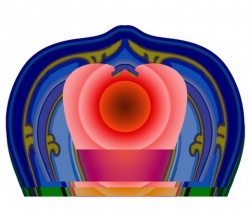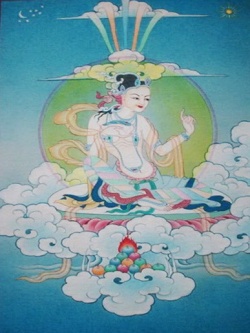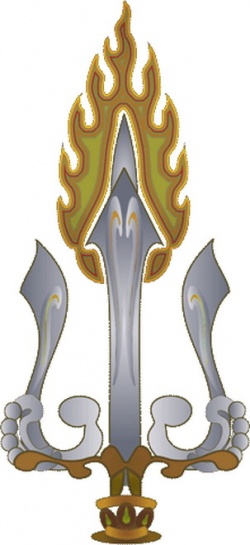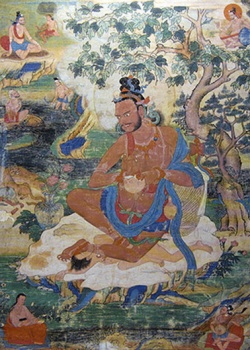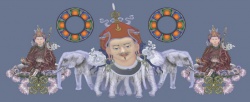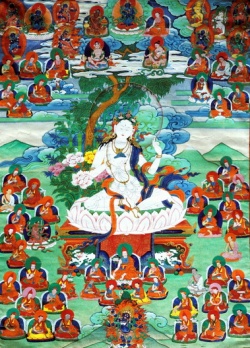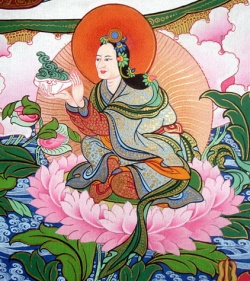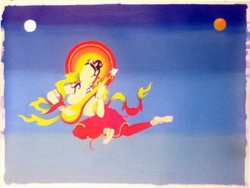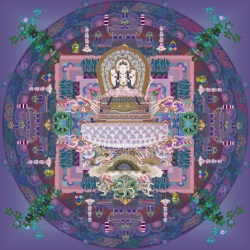The Worldly Dakini
Don’t ever speak of the Dakinis as if they were real, but at the same time one must accept them as an illusion that is a valid part of your life, if you are suitable and have chosen this pth. You may even with reservation consider the transcendental dakinis as an illusory image of your awakening potential, since it is they who may open the gate eventually for you. But beware, for it is easy to make false connections and declare that the Worldly Dakini is “unawakened” for she is trapped, as you are, in a stained existence within Samsara. That leads to the conceptual error that she too is subject to suffering, infirmity and death. That may be consoling to some who suffer, but that is not true. The Dakini has no Identity. It is you who have the Identity and it is you who suffers, becomes infirm and will die.
The idea that she can be in thrall to a god or other being, and can act as a trickster, a messenger or guide on the part of that being is a misconception. They do not in themselves embody like the Greek spirits flaws in character , conductive to negative Karmic consequences. It is you that has the flaws in character conductive to negative consequences.
Far better that they be considered as a transcendental aspect of your own life force, a warrior if you will.
In the Chandi Purana, which is a version of the myth of Durga who we have met before, who overcame the buffalo- demon, Mahish'ashura. In this legend she liberated innumerable female warriors called the Yoginis. They were warriors and had a lust for flesh, blood, bone and marrow to win the battle. Thay fought with the demons until Durga’s battle was won. Thus Durga used the combative force in order that “good” would triumph.
Likewise the Life Force is not a benign force that accepts what is not natural. It is true that ten or twelve thousand years has obscured its power, but the Life Force can fight for natural survival, particularly against Identity which is its destroyer.
What is the weapon of these Dakinis? There is a certain amount of instinctive and primitive knowledge that can be conceptually transferred to them, but their main weapon is the Dharma. But not the natural Dharma. It is the written and spoken Dharma. The Dakini becomes a visualized spokeswoman for the Dharma stored either consciously or subliminally in memory, which has previously been established by teachings or sacred texts. Why is that any better than simply drawing that information from memory directly without using the Dakini visualization? It is really a matter of the better efficacy of stimulus response chains.
Everything is stored in memory within great web in which the nodes are connected. When an irritation impinges on the system the signal enters and all connected nodes are stimulated. Any or all of that information may be brought forward for use in generating the appropriate attitudes which will form the base for the generation of intentions. In the normal human creatures memory there is such staining that almost all teachings which have entered directly are infected by anterior Identity demands.
If Dharma, however is entered in association with the Dakini idea or image, then any external or internal Dakini prompt will allow that information to arise with a very low probability of contamination. Now the great secret in controlling Dakini presentation of Dharma is to condition the Dakini presence in either an envisioned form or an imagined connection with any new and novel stimulus in the environment. A high flying bird, a naked child, an old woman, a crooked tree, corpse or even a strange event, would be sufficient. These prompts may be taken as signs or a conversation may develop between the apparent Dakini and the practitioner. Those conversations can be real and internally interpretedor imaginary it matters not one bit. What is important is that the internalization takes place and that the adept generates correct attitudes, correct intentions, correct preparation to respond and correct actions, and above all the ecuaninity of Buddha dharma. But it would not be efficient for the Dakini prompt to be constantly present, but fortunately there is always new and novel stimulation.
Now you can see that if any internal doubt or anxiety is coupled with the presence of a new stimulation and the existence of a new surprising stimulation is conditioned so that it provokes Dakini presence and her accompanying Dharma, we have a perfect Jiminy Cricket. Since no “dakini-dharma- novel stimulation” response chain can ever be fully clear of stained Identity, then we can say that the Dakini process is not pure and remains worldly to that extent. The more one advances upon the path however the purer will be the response chain. In the Dakini practice, then the Dakini becomes a useful intervening variable that filters stained sensations, discrimination, perceptions volitions and even consciousness itself.
But it is evident that the slightest misunderstanding or staining of the process increases defilements and does not decrease them. Confidence and a belief in the Dakinis I not detrimental, but the clinging to the appearances as if they were real is a great problem and is actually difficult to diagnose for oneself. Just the denial of this psychological Dakini presence and the blind insistence on the occult or transcendental mystery, the truth of legends and appearances is totally in conflict with the Buddha dharma of Buddha.
Before we look at the conditioning of these Dakini chains let us examine an example of Dakini appearances in classical literature. In this legend two Dakinis apper, one in the form of an old women and others in the form of visitations or visuliztions. Both types are transcendental Dakinis that show the path, but neither is the Supreme Dakini which is used within the actual meditation itself.
The legend of Mahasiddha Tilopa (988 - 1069) tells us about his handling of the Dakinis. We however the fundamental truth hidden behind the legend and see precisely how one must interact with them. There must always be the two, levels present;
1. The acceptance of the illusion completely with confidence in the message which comes from your own Buddha source.
2. The knowledge that as illusion it has no substance or reality.
These two must be perfectly balanced, for if there is too much weight on the former there is delusion and if there is too much weight upon the second there is a lack of confidence that permit Mara to enter.
Let us look at the moments when the great master Tilopa Meets the Dakinis, basically according to the presentation of his student Naropa, which is more fiable.
Naropa tells us that Tilopa’s father was the Bengali brahman Salwa and his mother brahmani Saldenma. He was called Salö. At his birth as was the custom showed him to knowers of signs and astrologers. As normal (the soothsayers were no fools) all the good and auspicious signs and omens in the world were complete. They were not sure whether Salo would become a god, a naga, a yaksha or a Buddha his parents had him taught the Vedas and Indian literature and he became knowledgeable.
One day while tending the water buffalo, he encountered a ugly woman, with a strange aspect. She told him that he continue herding buffalo, but to read the scriptures, because he would find the scriptures there. Then it is said she disappeared.
Later while he was reading under a tree, she returned, and asked him who he was. He told her but she told him that that was incorrect. She declared:
"Your country is Oddiyana in the North; your father is Chakrasamvara; your mother is Vajrayogini: your brother is Panchpana], and I am your sister, Bliss-giver. If you want to find the true buffalo go to the forest of the bodhi tree. There the stainless Dakinis hold the ear-whispered teachings."
He said that he was afraid to go there because he thought that the Dakinis would present obstacles, but she told him that he could get the teachings because he had received the predictions at birth and had kept the samaya vows, which were special commitments observed by a tantric disciple.
We can see then that this Salo was no ordinary boy for he was a good scholar, had a favourable birth, received a good education and must have taken the Tantric vows and therefore knew well the potential use and value of the presence of the Dakinis.
He then realizing that she was a Dakini confessed that he thought that the path to liberation was difficult and that he did not know how to walk upon it correctly.
She replied by telling him to start his journey and giving him her blessing and various tokens, a crystal ladder, a jeweled bridge, and a coral-handled key.
There we have an appearance of a Dakini from his own mind and his skilled reactions to her. What were the essential factors? First he was well informed. Second he was open and flexible without resistance to the message from his unconscious. Third he allowed no Identity interference and finally he had confidence in the dakini nessage without doubting it.
As a result this tender of Buffalo, known later as Mahasiddhi Tilopa, traveled to Oddiyana to encounter greater truths.
If one believes the dakini to be real. Spiritual being, one looses th power an majesty of the history, because that makes him merely a victim of external forces. If you see that he had prepared himself to receive an outside event into a vehicle for the correct attitudes, intentions and actions which were for the benefit of all sentient creatures then you enter into the world of the true illusory magic of the Dakinis and can prepare yourself for the same experiences.
Legend tells us that in Oddiyana he used the magic tools given him by the Dakini. We are told that using the magical tools he passes over a poison lake and the "iron wall” of Ghandola. Then, arriving at the three gates to the Temple of Shri Ghandola he met the dharmakaya mother wisdom dakini. He enters and with his coral key he opens the three seals of three treasure chests. Thus he received oral instructions of the three-fold wish fulfilling gem granting:
The view that need not be viewed.
The meditation in which there is no need to meditate.
The action in which one need not act.
As fruition just by receiving these Dharmas of Awakening he was naturally liberated without effort.
That is Naropa’s account, but what does legend of the lamas tell us? It says that after he had assumed a state of meditatione host of attending Dakinis got angry, declaring that he was insulting the mother of the Buddhas of the past, present and future. They wished to beat him, but the Mother Dakini intervened saying that he is ". . . . The father of the Buddhas of the Three Times. Even a rain of vajras . . . Could not destroy him. Therefore I will give him the teachings."
She instructs him in breathing meditations and other elementary practices, but he insisted that he wanted “ the Perfect Teaching. The Stainless Bliss, the Great Secret of the Ordinary and the Extraordinary."
Now is when this tale is finally in principle accord with the clear and simple rendition of Naropa, but bearing the unnecessary embellishments. The legend says that she then agreed to confer, if he could understand the signs, the three wish-fulfilling gems which include:
1. The self-arising body of co-emergent Wisdom and Means united;
2. The speech that is the 7-syllable Self-arising Emerald in the Dharmakara
3. The 5-pointed Vajra jewel of self-arising mind.
The host of Dakinis express their doubt that he will be able to understand the signs, but Tilopa responds directly to the Mother, that he understood. He declared that they were:
1. The self-liberation of Samaya that grants access to "the light of wisdom which dispels the darkness of ignorance, to self-awareness, self-arising, ad self-clarity.
2. The experience which opens the door to the mind-as-such, Self-appearing clarity which is ever unborn.
3. The experience of the realized yogi that opens the door to Mind-as-such, Dharma-as-such, and Dharmakaya.
Now examine these three together with the rendition of Naropa, himself a master of Mahamudra. After correct Mahamudra meditation it is clear that he encountered the truth regarding:
The view that need not be viewed.
2. The meditation in which there is no need to meditate.
The action in which one need not act.
You can see that the renditions are quite different. The former float in the air without substance but are delightful. That of the Indian Naropa is quite clear and coincides perfectly with the practice of Mahamudra and also Chan Dharma. This shows how careful one must be when listening to teachings. Which would you choose?
As he was leaving, a formless Dakini bestowed 9 special objects with specific instructions to:
Loosen the knot of the mind
Act like a sword striking water
Chase the sun of realization
See Samaya in the mirror of your mind
See that the light of awareness is wisdom
Turn the wheel of the channel and wind net
See the outer mirror equalizing taste
See the Mahamudra of self-liberation
Hold the jewel of great-bliss speech
Here at least we come to a more direct and evident advice for an advanced meditator who understands what is being said beyond the mere words and is ready for Mahamudra. But the object here is not to present at the moment meditation advice, particularly for the Mahamudra adept, but to show the extent of true Dakini practice, it’s limitations and its dangers when too much legend and decoration is attached. Certainly the embroidery on the handkerchief is beautiful and seductive, but it has little value if the handkerchief cannot be used except as an ego decoration peeping discretely from ones pocket.
Let us finally look at another Dakini aspect which might appear rather strange to anyone external judging the situation. Tilopa constantly aware of the internl stuggle from his mind engendered without conscious awareness of doing so another Dakini. It was after he had renounced the world. One day he had a vision of a dakini who generated within him impulses declaring “Speak like a madman, throw off your robes and practice in secret”. That is precisely what he did trusting in his inner Buddha Nature. He distanced himself from all traditional values and rules and acted in quite unconventional manners, which today would without doubt send him into a home with a straight jacket. But it was later clear that this behavior served him as a rapid and direct method for renouncing deceptive comforts and egoistic existence within society.
The Mundane Dakinis work well, but one must be aware and not fall into the trap of letting the Identities themselves evoke imitations which serve desire and aversion. Yes there are many traps to be avoided.
